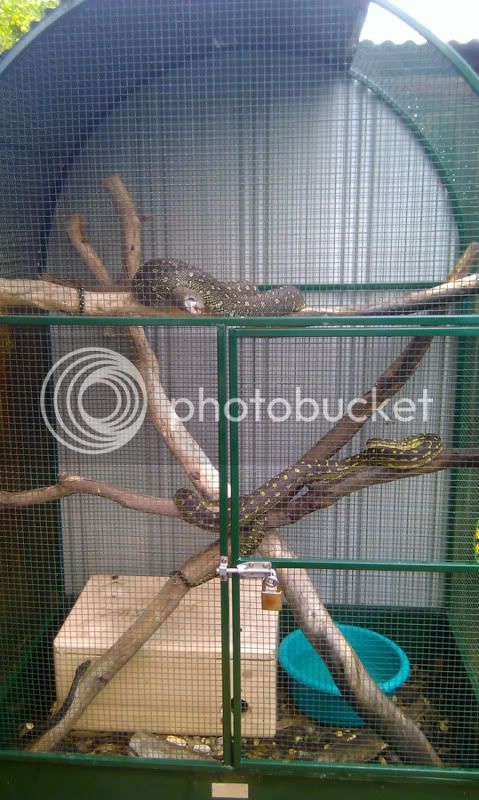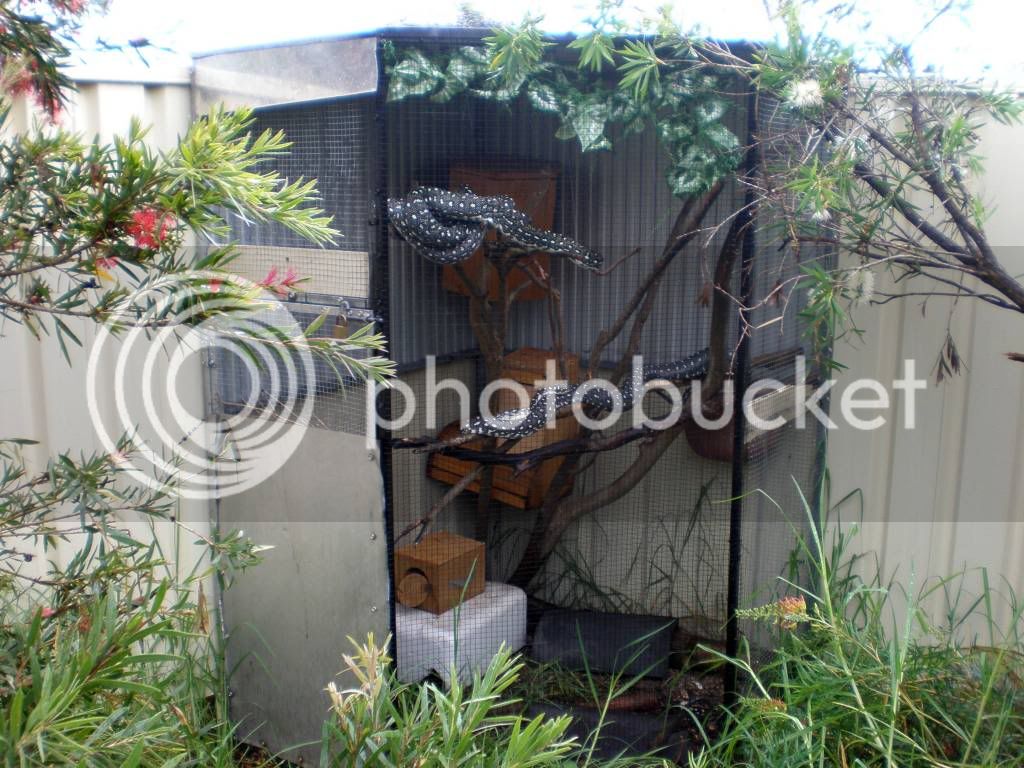You are using an out of date browser. It may not display this or other websites correctly.
You should upgrade or use an alternative browser.
You should upgrade or use an alternative browser.
Winter cooling - Diamonds
- Thread starter Striker
- Start date

Help Support Aussie Pythons & Snakes Forum:
This site may earn a commission from merchant affiliate
links, including eBay, Amazon, and others.
- Status
- Not open for further replies.
Hoplophile
Active Member
Well today 25 April 2012 is cold and wet (12 degrees and its been raining heavily). For anyone who doubts that Diamonds don't like it cold here's some convincing evidence. At 12.30pm all three of mine were out and active (slow mind you) and this is typical of my snakes throughout winter in Melbourne. And it's not an artifact of captivity. A friend of mine found one out and about at Ben Boyd N.P. in southern NSW in August. Again it was around 12 degrees and drizzling. In APPROPRIATE enclosures this species does need heating outdoors in Melbourne. These animals are outdoor 5 year captives. This pic taken today at around 12.30.

The longest lived captive Diamond I'm aware of was about 16 years. It was on display in the Zoology Department at Monash University and died sometime in the 1980's. It was in a large glass fronted case with a basking branch, a mesh top and a large waterbowl. He ate a rat about every month, less over winter. Basking temperature in the 30's from 0900-1700 and "Monty" shuttled from under the light to curled up in the corner. At night the temperature dropped down to whatever the building temperature reached (I'd guess 10-15 degrees by early morning). He was obtained as a wild caught "teenager" and was a celebrity to a couple of decades of students there. He was a true Diamond, not an intergrade and was black with scattered cream spots - I don't know where he was caught. Replicate that and you probably have a winning husbandry combination (you might have to get a bunch of students to press their noses against the glass daily to fully replicate the set-up. :lol:

I know everyone has their own opinions but we need to learn from each other and if someone out there has a 25 year old Diamond Python please PM me and tell me the secret because I do not want to loose another one in their prime.
The longest lived captive Diamond I'm aware of was about 16 years. It was on display in the Zoology Department at Monash University and died sometime in the 1980's. It was in a large glass fronted case with a basking branch, a mesh top and a large waterbowl. He ate a rat about every month, less over winter. Basking temperature in the 30's from 0900-1700 and "Monty" shuttled from under the light to curled up in the corner. At night the temperature dropped down to whatever the building temperature reached (I'd guess 10-15 degrees by early morning). He was obtained as a wild caught "teenager" and was a celebrity to a couple of decades of students there. He was a true Diamond, not an intergrade and was black with scattered cream spots - I don't know where he was caught. Replicate that and you probably have a winning husbandry combination (you might have to get a bunch of students to press their noses against the glass daily to fully replicate the set-up. :lol:
Last edited:
GSXR_Boy
Very Well-Known Member
This is my set up. Currently getting sun from about 7am to approx' 10/11 am and then a little bit of filtered afternoon sun. I have some roof tiles on the floor that hold heat for a bit after the sun has gone. One animal sleeps under one tile and the others sometimes use it for the heat when they have had a big meal ( like their last feed of two jumbo's the other week). I have lined the hides with styrofoam and have also since the pic' installed a pvc pipe behind the vine so they can use some heat from the roof over winter ( kind of emulating house rafters etc). I will also be putting some perches up there close to the roof ,just for winter as the tin gets rather hot in summer. And a few wind breaks along thr top and bottom.
That pic' was taken last week ( 19th) and the day was overcast with sparodic patches of sun. As you can see on the floor in the pic's it had just finished raining but they were all out.( they love sitting in the rain) Their body temps rose pretty fast with the patchy sun. As it is mostly cloudy the body temp' on one is 18.3 and another 21.5, But on other cloudy days i have measured their temps at around 32c within half an hour of basking in sun that has come out.
Will they be okay over winter, that remains to be seen, but they seem to be doing everything right so far!

That pic' was taken last week ( 19th) and the day was overcast with sparodic patches of sun. As you can see on the floor in the pic's it had just finished raining but they were all out.( they love sitting in the rain) Their body temps rose pretty fast with the patchy sun. As it is mostly cloudy the body temp' on one is 18.3 and another 21.5, But on other cloudy days i have measured their temps at around 32c within half an hour of basking in sun that has come out.
Will they be okay over winter, that remains to be seen, but they seem to be doing everything right so far!

Last edited:
veenarm
Well-Known Member
- Joined
- Dec 15, 2010
- Messages
- 337
- Reaction score
- 0
Damn that's nice...
I would LOVE to keep mine outdoors but as I am in Canberra and it gets to -6 some nights, I really don't think it's an option....
Maybe I should move back to the Gong so I can do it
I would LOVE to keep mine outdoors but as I am in Canberra and it gets to -6 some nights, I really don't think it's an option....
Maybe I should move back to the Gong so I can do it
Hoplophile
Active Member
It gets to negative temperatures here in Melbourne as well, but not a frequently and not as cold. And I live not far from Port Phillip Bay which probably moderates temperatures a bit. An outdoor enclosure could work in ACT if there were lots of protected areas, particularly from frost. I'd be inclined to have some supplementary heating (only a little) in ACT though.
Well today 25 April 2012 is cold and wet (12 degrees and its been raining heavily). For anyone who doubts that Diamonds don't like it cold here's some convincing evidence. At 12.30pm all three of mine were out and active (slow mind you) and this is typical of my snakes throughout winter in Melbourne. And it's not an artifact of captivity. A friend of mine found one out and about at Ben Boyd N.P. in southern NSW in August. Again it was around 12 degrees and drizzling. In APPROPRIATE enclosures this species does need heating outdoors in Melbourne. These animals are outdoor 5 year captives. This pic taken today at around 12.30.

The longest lived captive Diamond I'm aware of was about 16 years. It was on display in the Zoology Department at Monash University and died sometime in the 1980's. It was in a large glass fronted case with a basking branch, a mesh top and a large waterbowl. He ate a rat about every month, less over winter. Basking temperature in the 30's from 0900-1700 and "Monty" shuttled from under the light to curled up in the corner. At night the temperature dropped down to whatever the building temperature reached (I'd guess 10-15 degrees by early morning). He was obtained as a wild caught "teenager" and was a celebrity to a couple of decades of students there. He was a true Diamond, not an intergrade and was black with scattered cream spots - I don't know where he was caught. Replicate that and you probably have a winning husbandry combination (you might have to get a bunch of students to press their noses against the glass daily to fully replicate the set-up. :lol:
wow that Diamond at the bottom is stunning!!
serpenttongue
Very Well-Known Member
This WAS my diamond set-up. Diamonds tend not to like intense sunlight for long periods, so I had it covered with shade cloth (this also helps ferns/vines to grow in there, and keep things a bit cooler). But as you can see, I had 'windows' in the front so the diamonds could bask in full sunlight.
Attachments
Unfortunately Diamonds are the first snake recommended to most new amateur herps (probably because of their temperament) but the more I keep and the more I learn I think they're one of the most complex to look after properly.
This is a point that has to be emphasised so much more. When you consider the effort people go to in getting things just right for a GTP, it's amazing how casual the approach often is when it comes to keeping diamonds. They require work and understanding - but the rewards are great. Extraordinary animals.
Just an update seeing it was discussed a fair bit in this thread (Ian I hope you're still reading) - I have since moved a female adult diamond and coastal outdoors into an aviary. The difference in is unbelievable. Both are way more active, out and about more often instead of in their hides, loving the rain, etc. Dimensions 1.8m tall, 1.8m long and 1m deep. They were fine in their indoor enclosure, ad their temps were definitely right. I guess it's just the extra space and the great outdoors. I have another aviary the same size almost ready to go to move the last one (male) outdoors. At this stage outdoors definitely seems like the way to go if you live in a similar climate.
Perko
Well-Known Member
- Joined
- Aug 11, 2008
- Messages
- 960
- Reaction score
- 1
I was given a adult Diamond in 1983 that i had for just over 16yrs, the snake would have been easy over 20yrs old.
Gary Valle in the US has Diamonds in there mid 20's and a 23yr old that just laid a healthy clutch!
Gary Valle in the US has Diamonds in there mid 20's and a 23yr old that just laid a healthy clutch!
The longest lived captive Diamond I'm aware of was about 16 years. :lol:
MR_IAN_DAVO
Well-Known Member
- Joined
- Nov 18, 2010
- Messages
- 858
- Reaction score
- 1
This an old thread but a good one. There has been some questions on Diamond Python housing & temps just recently so i thought i would bump this back up to the top.
Please take the time to read it, there is some very helpfull information in this thread.
Cheers
Ian
Please take the time to read it, there is some very helpfull information in this thread.
Cheers
Ian
- Status
- Not open for further replies.
Similar threads
- Replies
- 7
- Views
- 2K
- Locked
- Replies
- 35
- Views
- 5K



